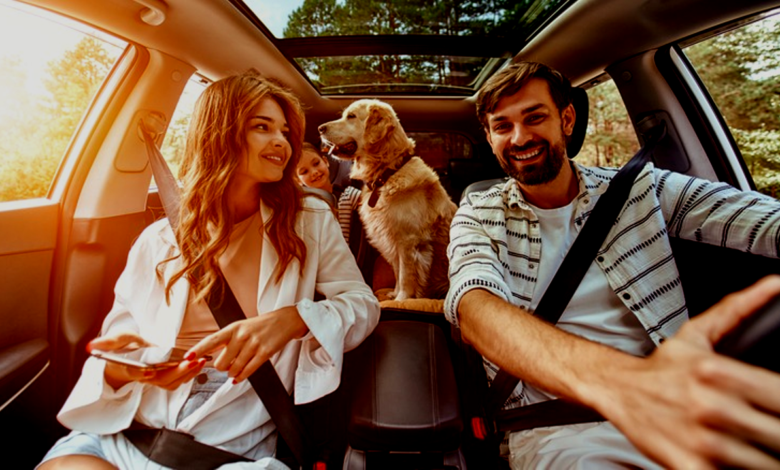
Traveling with Pets Safety Tips for Road Trips and Flights
Traveling with pets safely Get essential tips for stress-free road trips & flights with your furry companions Keep them secure & comfortable.
Traveling with pets can be an exciting adventure, but it requires careful planning to ensure their safety and comfort. Whether you’re hitting the road for a weekend getaway or boarding a flight for a long-distance trip, your furry companion relies on you to make the journey as smooth as possible. From choosing the right carrier to managing anxiety and meeting travel regulations, pet owners must take several precautions to keep their pets secure and stress-free. This guide provides essential tips for both road trips and flights, helping you prepare for a safe and enjoyable trip with your four-legged friend.
Proper preparation is key to a successful trip when traveling with pets. A well-planned journey reduces risks and ensures your pet remains calm and healthy throughout the experience. By understanding the best practices for pet travel including pre-trip vet visits, proper packing, and in-transit care you can create a positive experience for both you and your pet. Whether you’re a first-time traveler or a seasoned pet owner, these safety tips will help you navigate the challenges of road trips and flights with confidence.
Traveling with Pets Safety Tips for Road Trips and Flights
Veterinary Preparation and Documentation
Before traveling with your pet, schedule a comprehensive veterinary check-up to ensure they’re healthy and fit for the journey. For air Traveling with Pets, obtain an up-to-date health certificate (typically required within 10 days of departure) and confirm all vaccinations are current. Discuss potential travel-related issues like anxiety or motion sickness with your vet they may prescribe Traveling with Pets aids, anti-nausea medication, or suggest natural remedies like pheromone sprays. If traveling internationally, research destination-specific requirements, which may include additional vaccines (such as rabies titers), parasite treatments, or quarantine protocols. Keep all medical records organized in a waterproof folder for easy access during your trip.
Identification and Carrier Acclimation
Secure proper identification for your pet using both a permanent microchip (registered with current contact details) and a durable collar tag displaying your phone number and destination address. For carrier training, begin weeks before your trip: for road trips, gradually increase car ride durations while rewarding calm behavior with treats; for flights, let your pet explore their airline-approved carrier at home with cozy bedding and familiar scents. Pack a dedicated travel kit including collapsible bowls, portioned meals, bottled water, medications (with instructions), waste cleanup Traveling with Pets, and comfort items like their favorite toy or an unwashed t-shirt with your scent to ease stress.
Safety Tips for Road Trips with Pets
Safe Containment and In-Transit Precautions
Always secure your pet in a crash-tested travel crate or with a certified pet seatbelt harness during road trips unrestrained pets can become dangerous projectiles during sudden stops. Choose a well-ventilated carrier sized appropriately for your pet to stand, turn, and lie down comfortably. Position the crate in the back seat (never the front with airbags) or cargo area of sport utility vehicle (SUV), using non-slip mats and tethers to prevent shifting. Maintain a climate-controlled environment (68-72°F ideal) using sunshades on windows and never leave pets unattended interior temperatures can become lethal within minutes, even with windows cracked.
Strategic Breaks and Comfort Management
Schedule 15–20-minute breaks every 2-3 hours at pet-friendly rest stops, keeping dogs leashed with a secure harness (not just collar) and cats in escape-proof carriers during stops. Create a “pit stop kit” with collapsible water bowl, bottled water, waste bags, and high value treats to reward calm behavior. Feed light meals 3-4 hours pre-departure and offer small water portions during stops to prevent carsickness consider ginger treats or vet-approved anti-nausea medication if Traveling with Pets. Play white noise or classical music at low volume and use pheromone sprays (Adaptil for dogs/Feliway for cats) on bedding 30 minutes before travel.
Flying with Pets Airline Regulations and Safety Measures
Airline Compliance and Cabin Travel Preparation
Each airline maintains unique pet policies with strict size/weight limits for in-cabin travel (typically under 20 lbs including carrier). Research requirements 2-3 months pre-flight, as many carriers limit the number of pets per cabin and may charge 95−250 each way. For in-cabin pets Measure your pet standing to ensure they fit in an airline-approved soft-sided carrier (usually 18″L x 11″W x 11″H). Book early for pet spots and select window seats for less foot traffic. Attach a waterproof ID sleeve with your contact info, destination address, and rabies tag.
Cargo Hold Safety Protocols
For pets too large for cabin Traveling with Pets Book on pet-friendly airlines with temperature-controlled cargo holds (avoid Boeing 737s in summer). Use an IATA-compliant hard kennel labeled “Live Animal” with 1.5x your pet’s standing height. Freeze a water bowl to prevent spills that will melt during flight. Provide an unwashed t-shirt with your scent but no loose bedding. Confirm your pet’s airway bill number and track the cargo loading/unloading process. Avoid early morning/late evening flights when temperatures are most extreme
Managing Pet Anxiety During Travel
Many pets experience anxiety during Traveling with Pets due to unfamiliar environments and motion. Recognizing signs of stress such as panting, whining, or excessive drooling can help you take corrective measures. Calming aids like pheromone sprays, anxiety wraps, or vet-approved medications may be beneficial. Maintaining a calm demeanor reassures your pet, as they often pick up on their owner’s emotions. Providing familiar items, like a blanket or toy, can offer comfort. For long trips, gradually increasing travel duration in advance can help your pet adjust.
Post-Travel Care for Pets
After reaching your destination, give your pet time to decompress. Offer water and a light meal and allow them to explore their new surroundings at their own pace. Monitor their behavior for signs of illness or stress and stick to their regular routine as much as Traveling with Pets. If flying, check for any signs of distress or injury, especially after cargo travel. Schedule a vet visit if you notice anything unusual. Providing extra affection and reassurance helps your pet feel secure after the journey.
Read More: Dog Obedience Classes in Texas Which Ones Are Worth It
Conclusion
Traveling with pets can be a rewarding experience when approached with proper planning and care. By following the safety tips outlined for both road trips and flights, you can ensure your furry companion remains comfortable, secure, and happy throughout the journey. From pre-travel vet checkups to choosing the right carrier and managing in-transit stress, every precaution you take makes a difference in creating a positive travel experience for your pet.
As you prepare for your next adventure, remember that traveling with pets requires patience and attention to their unique needs. Whether it’s a short car ride or a cross-country flight, prioritizing their well-being will lead to smoother travels and cherished memories together. With the right preparation and mindset, you and your pet can enjoy many safe and joyful journeys ahead.
FAQs
Can I sedate my pet for travel?
Sedation is generally not recommended unless prescribed by a vet, as it can affect breathing and heart rate, especially during flights.
What documents do I need for flying with a pet?
Most airlines require a health certificate issued within 10 days of travel, proof of vaccinations, and any additional permits for international Traveling with Pets.
How can I keep my pet calm during a road trip?
Use familiar blankets or toys, take frequent breaks, and consider calming sprays or vet-recommended anxiety treatments.
Is it safe for pets to travel in cargo?
While generally safe, cargo Traveling with Pets can be stressful. Choose airlines with climate-controlled cargo holds and avoid extreme weather conditions.
How often should I stop for my pet on a road trip?
Plan breaks every 2-3 hours for bathroom needs, hydration, and a chance to stretch their legs.







